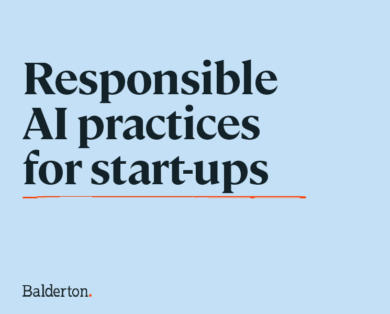- 09 April, 2025
This is the third post in a series on the top five mistakes European startups make in US expansion. This post addresses mistake number two: not adapting your structure and processes as you expand. In other words: thinking that the US expansion is only about the US, and not about the entire company.
The mistake is thinking US expansion is just about the US, and not about the entire company.
The reality is that US expansion, in the vast majority of cases, isn’t just about them, it’s about you as well. You need not only to define structure and process within the US entity, you need to change structure and process within the existing company as well. In short, you generally can’t treat the US as “just another country.” Failing to realize that and act accordingly is what mistake number two is all about.There are two primary ways that companies make this mistake:
- Treating the USA as just another country
- Moving a founder to the USA and thinking that alone is enough
The Danger of Treating the US as Just Another Country
There are several reasons why it’s dangerous to treat the US as just another country in your international expansion:
It’s large geographically.
We all know this intellectually, but to make it visceral remember: a flight from Boston to San Francisco is 500 miles longer than a flight from London to Tel Aviv. You’ll need a geography strategy and one that takes industry clusters into account.
It spans more than four time zones (technically six).
The incremental time difference with Europe as you move west should be an important factor in locating your US headquarters and/or key employees. Even within the US, time zone needs to be a factor in geography strategy and staffing (e.g., technical support hours).
It has a deceptively strong regional culture, particularly when it comes to building relationships in sales.
As a friend once said, “don’t try to sell in Cleveland if you can’t talk about the Browns for 30 minutes.” We’re all Americans at one level, but at another level we’re not. Even East Coasters and West Coasters sometimes need a translation guide to communicate.
US technology employees are not accustomed to working at a foreign subsidiary.
In most other countries, even those where there is a strong local technology ecosystem, most of the labor pool has experience in working within subsidiaries. It makes many jobs different, sometimes subtly, but particularly so for leadership positions.
The US market is usually more competitive.
As William Gibson said, “the future is already here, it’s just unevenly distributed.” In that sense, the US market is usually the place you will find the most and the newest competitors. This can be a key benefit of opening in the US market, but you’ll need to be set up to listen to the signal the market is sending.
US customers can be more demanding.
They demand a high level of responsiveness. They are more than happy to use leverage and/or threaten to switch vendors. They can be less relationship-oriented and more quick to say, “sorry, but it’s just business.” Overall, this is good because it keeps your company on its toes. But some of your global processes (e.g., R&D response time to customer-reported bugs) will need to change if you want to meet US responsiveness standards while managing a distributed organization. If a seller needs approval for a 50% discount at 3pm on a Tuesday, the deal may be lost before Europe opens on Wednesday.
US customers often buy differently.
They can be less purely product-centric, care more about solving problems than buying the best technology, and care more about vendor viability – particularly when the vendor is “some European startup” with a name they can’t pronounce, backed by investors they don’t know, and with an executive team who has only worked at companies they’ve never heard of.Tie all this together and you end up running the US by remote control, changing little about how the company operates worldwide, and making infrequent visits, usually to see rather frustrated employees.
Why Moving A Founder To The USA Alone Isn’t Enough
Many companies recognize that relocating a founder to the US can be both personally beneficial for the founder and highly beneficial for the company. Ideally, the founder in question is the CEO, but the idea can also work with other founders, such as the CTO or CPO (chief product officer). Because many European founders want to return at some point, this is frequently done as a two to four year expatriation, rather than a permanent relocation. As someone who relocated to France for two years and stayed five, I can say you’re never sure what will happen, but it’s good to have a plan at the outset. One year is better than nothing, but I’d personally recommend planning for a minimum of two.While a founder relocation certainly demonstrates high commitment to the success of US expansion, some companies get confused and think that’s the only thing they have to do. Just move the founder to NYC, slide standing meetings back towards the end of the day in Europe, and voila, we’ve done it.Not so fast. Doing that fails to consider all of the bullets in the prior section – e.g., determining how the company will be sufficiently responsive to US customers or factoring new US-only competitors into its product planning. One can argue that relocating a founder/CEO will help them personally experience the factors mentioned above. It will, and you will eventually learn most of the lessons. But doing so fails to leverage the knowledge and experience of those who went before you, and relearning that will cost your company valuable time and money. Far better to relocate a founder/CEO to the US and start with a list of processes that need review and structures that need revisiting.To be corny but mnemonic: opening the US should change U. If it doesn’t, you may be treating the US as just another country, and that can lead to trouble downstream.
What You Should Do Instead
To avoid structure- and process-related problems in your US expansion, here’s a list of things you should do:
Review major operational processes
Review major operational processes to ensure they work for customers and employees in all US time zones and at US speed. For example: support escalation, R&D bug response, product requirements gathering, marketing prioritization, sales quotes, finance approvals, HR approvals, and internal support tickets. Can you move fast when you need to – or are the Americans always “waiting for Europe?”
Review strategic processes
Review your strategic processes to ensure they adequately reflect the signal you should be getting from US customers, competitors, and market trends. For example: your strategic planning process and product planning process. The question is simple: are you listening to the US market enough in your planning? This is hard, because your US ears need to be disproportionately large relative to your US sales in the early days — and instead proportional to the market opportunity and information value of the signal. You will hear, more than a few times, “but we Europeans are bringing in all the revenue, and the Americans are getting all the attention.” And they’ll be right. But you should do it anyway.
Review your organizational structure
Review your organization structure to ensure you have enough senior positions in the US both to adequately represent the voice of the USA and to be able to deliver local approvals for key decisions. How many CEO direct reports should be in the USA vs. Europe? Which ones? If the CEO is in Europe, is there a head of the US organization (e.g., President, GM, CRO) empowered to make key decisions? Many companies decide to put their worldwide head of sales (e.g., CRO) and their worldwide head of marketing (e.g., CMO) in the USA while leaving other functions in the home country. Some prefer distributing the other positions as well.
Build a US geography strategy
Build a US geography strategy, starting by picking a city for your US headquarters – even if there is no office. Most companies should choose cities in the Eastern time zone to minimize the time difference and the flight time to your home country in Europe. Popular choices include New York, Boston, Atlanta, and Miami. Be sure there are non-stop flights to your home country airport.
Develop your US geography strategy
Develop your US geography strategy by first thinking about your target customers. The US has geographic industry clusters that are important if you are following either a vertical overall or vertical-beachhead go-to-market strategy.Such clusters include: financial services in NY, insurance in CT, oil & gas in Texas, pharma in NJ, manufacturing in the Midwest, entertainment in LA, tech in Silicon Valley, and crypto in Miami.Even with a remote sales model, it can be helpful to have the ability to visit customers, hold meetups, and do marketing events at an industry hub.
Complete your US geography strategy
Complete your US geography strategy by thinking about employees.
- From which companies do you want to hire?
- Where are their employees?
- Do you want to have offices?
- Do you want people to come in and if so how many days per week?
- Even if you’re purely remote, do you want to be able to have Friday meetups or host regional Holiday parties?
- Think about timezones: e.g., should a first-time SDR be separated from their manager by three hours?
Finally, think about the regional cost of living and how to avoid paying a San Francisco wage to employees in Jackson, Mississippi. My general advice here is to establish one to three regional clusters and try to hire employees near them. This makes everything easier: from regional meetups to holiday parties to QBRs to compensation to cross-training. Unless you really, really don’t care about location, there’s nothing worse than having 31 employees in the USA spread across 3.1M square miles with no two people in the same place. Far better, in my opinion, to have three clusters, one in the NY area near the US HQ, one in Austin for engineering, and one in Salt Lake City for support and services. You can find the people if you pick the (right) place. If you don’t pick a place first, you will invariably end up with people everywhere. If you’re OK with that, great. Just don’t accidentally back into it.
Review your sales processes
Review your sales process to see if it is sufficiently solutions-oriented. Review marketing tools to ensure they support a solutions-oriented sales process (e.g., and aren’t just producing data sheets). Review the sales hiring and onboarding process to see if it meets the needs of US sellers.In the next post in this series, we’ll dive into mistake number three, hiring the wrong people.

 DAVE KELLOGG
DAVE KELLOGG 












